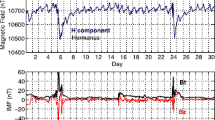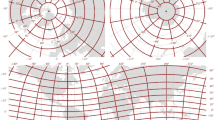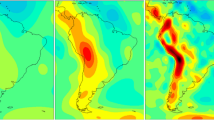Summary
In 1981 a German permanent wintering-over base — the Georg von Neumayer station (GVN) — was established. Since then, geophysical and meteorological parameters have been recorded continuously. Although it seems that an antarctic ice shelf is not suited as base for a permanent geophysical observatory, it could be shown, that the continous registration of the geomagnetic field vector at GVN is very useful for studies of ionospheric and magnetospheric phenomena. In order to separate true time variations of the geomagnetic data from local disturbances at first many careful statistical studies of the measured time series were necessary. For instance contaminating swell-effects could be detected, and it is important to distinguish these from geomagnetic pulsations.
With the methods of statistical frequency analyses, high frequency data sampled with 10 Hz were processed to obtain the daily variation of the occurences and mean periods of pc3-pulsations. A changing period of the recorded pc3-pulsations could be found. These daily shifts of the period are related to earthmagnetic shells with different L-numbers, moving over the Ekström Ice Shelf dependent on time of day and geomagnetic activity.
Furthermore the influence of the polar electro jet on geomagnetic depth sounding results could be derived from many soundings based on time series sampled at GVN with 10 Hz. Inhomogeneous parts in the magnetic time series with periods around 100 seconds are prominent indicators for the determination of the contact times of the auroral oval relative to GVN. With that, it could be shown that inhomogeneous parts generated mainly by the ionospheric field-aligned currents, are small for time series measured between 8 and 18 o'clock (UTC), that is where the geomagnetic activity moves between 2≤Kp≤3.
Zusammenfassung
Im Jahre 1981 wurde die deutsche Überwinterungsstation Georg-von-Neumayer (GVN) aufgebaut. Seitdem werden dort geophysikalische und meteorologische Größen kontinuierlich aufgezeichnet. Obgleich ein antarktisches Schelfeis nicht als Fundament für ein permanentes geophysikalisches Observatorium geeignet erscheint, kann gezeigt werden, daß die ununterbrochene Registrierung des geomagnetischen Feldvektors bei GVN sehr nützlich für die Untersuchung der Phänomene der Iono- und Magnetosphäre ist. Um reelle Zeitvariationen der geomagnetischen Größen von örtlichen Störungen zu trennen, sind zunächst viele sorgfältige statistische Studien der registrierten Zeitserien notwendig. Zum Beispiel konnten aufgeprägte Dünungseffekte gemessen werden, und es ist wichtig, diese von erdmagnetischen Pulsationen zu trennen.
Mit den Methoden der statistischen Frequenzanalyse sind hochfrequente Daten, die mit 10 Hz aufgenommen wurden, aufbereitet worden, um damit die tägliche Variation der Ereignisse und die mittleren Perioden der pc3-Pulsationen zu erhalten. Eine sich ändernde Periode der registrierten pc3-Pulsationen konnte gefunden werden. Diese täglichen Verschiebungen der Periode sind verknüpft mit den erdmagnetischen Schalen verschiedener L-Werte, welche sich über das Ekström-Schelfeis abhängig von der Tageszeit und der geomagnetischen Aktivität bewegen.
Weiterhin konnte der Einfluß des polaren Elektrojets auf Ergebnisse der erdmagnetischen Tiefensondierung aus vielen Sondierungen — bezogen auf 10-Hz-Daten von GVN — abgeleitet werden. Inhomogene Anteile in den magnetischen Zeitserien mit Perioden um 100 Sekunden sind bedeutsame Indikatoren für die Bestimmung der Kontaktzeiten des Polarlicht-Ovals relativ zu GVN. Damit konnte gezeigt werden, daß inhomogene Anteile, die hauptsächlich durch ionosphärische feldliniengerichtete Ströme erzeugt werden, für Zeitserien zwischen 8 und 18 Uhr UTC — falls die geomagnetische Aktivität zwischen 2≤Kp≤3 liegt — gering sind.
Résumé
C'est en 1981 qu'une base permanente d'hivernage allemande, la Station Georg Von Neumayer (GVN) a été mise en place. C'est à partir de ce moment que des paramètres géophysiques et météorologiques ont été enregistrés en continu. Bien qu'il semble qu'un inlandsis antarctique ne soit guère approprié pour accueillir un observatoire géophysique permanent, il a pu être montré que l'enregistrement continu à GVN du vecteur champ magnétique terrestre est très utile pour étudier les phénomènes ionosphériques et magnétosphériques. Afin d'isoler les variations du champ magnétique terrestre dépendant réellement du temps de celles induites par les perturbations locales, il a été nécessaire de procéder d'abord à des études statistiques nombreuses et soignées des séries d'observations synoptiques. Par exemple des variations ondulatoires ont ainsi pu être détectés et il est important de pouvoir les distinguer des impulsions géomagnétiques.
Avec les méthodes d'analye statistique de fréquence, des données de haute fréquence échantillonnées à 10 Hz ont été traitées afin d'obtenir la variation journalière des occurences et des périodes moyennes des pulsations pc 3. On a pu déterminer une période de changement des pulsations pc 3 enregistrées. Ces dérives journalières de la période sont liées au déplacement, en fonction de l'heure et de l'activité magnétique terrestre, de cellules géomagnétiques affectées de nombres L différents au-dessus de l'inlandsis d'Ekström.
On peut de plus déduire de nombreux sondages basés sur les séries temporelles de GVN fichées à 10 Hz l'influence du jet électromagnétique polaire sur les résultats des sondages géomagnétiques en profondeur. Les parties non homogènes, dans les séries temporelles de mesures magnétiques affectées d'une période de 100 secondes environ, sont des indicateurs remarquables pour la détermination des instants de contact de l'ovale aurorale à GVN. On peut ainsi constater que les parties non homogènes, principalement générées par les courants du champ ionosphérique orientés selon les lignes de force, sont réduites pour les séries temporelles mesurées entre 8 h et 18 h UT, c'est-à-dire au moment où l'activité géomagnétique varie entre: 2≤Kp≤3.
Similar content being viewed by others
References
Berdichevsky, M. and S. Zhdanov, 1984: Advanced Theory of Deep Geomagnetic Sounding. Elsevier Science Publisher B.V., Amsterdam, N.Y.
Brodscholl, A., 1988: Variations of the Earthmagnetic Field at GVN-Station, Antarctica: applied to the Methods of the Earth-magnetic Deep Sounding to Detect Two-Dimensional Anomalies of the Conductivity and for the Demonstration of the Influences of Ionospheric Current Systems. In: Berichte zur Polarforschung, No. 48/1988.
Dittus, H., 1986: Methoden der Registrierung und Datenverarbeitung für das Prospektionsverfahren „Passive Audio-Magnetotellurik”. Diss., München.
Feldstein, Y. I., 1973: ‘Auroral Oval’. J. Geophys. Res.78, 1210.
Hessler, V. P., 1970: Telluric, Geomagnetic, and Auroral Activity on Arctic Drifting Stations and at Pt. Barrow, University of Alaska, Final Report.
Jacobs, J. A., Y. Kato, S. Matsushita and V. A. Troitskaya, 1964: Classification of Geomagnetic Micropulsations. J. Geophys. Res., Vol.69, pp. 180–181.
Kamide, Y., J. D. Craven, L. A. Frank, B.-H. Ahn and S.-I. Akasofu, 1986: Modeling Substorm Current Systems using Conductivity Distributions inferred from DE Auroral Images J. Geophys. Res. Vol.91, pp. 11235–11256.
Liebig, V., 1986: Untersuchung zur Durchführung magnetotellurischer Messungen in der Antarktis unter Benutzung mikroprozessorgesteuerter Datenerfassungssysteme. Diss., Fak. f. Geowiss. d. Univ. München.
Pedersen, L. B., 1982: The Magnetotelluric Impedance Tensor. Its Random and Bias Error. Geophys. Prosp. Vol.30, 188–210.
Schmucker, U., 1980: Diskussionsbeitrag zu „Über die Unterschiede zwischen verschiedenen Definitionen der Induktionspfeile”. In: Prot. Koll. Erdmag. Tiefensondierung., Berlin-Lichtenrade.
Author information
Authors and Affiliations
Rights and permissions
About this article
Cite this article
Brodscholl, A., Miller, H. Magnetic observations at Georg von Neumayer station, Antarctica. Deutsche Hydrographische Zeitschrift 41, 159–172 (1988). https://doi.org/10.1007/BF02225925
Received:
Accepted:
Published:
Issue Date:
DOI: https://doi.org/10.1007/BF02225925




